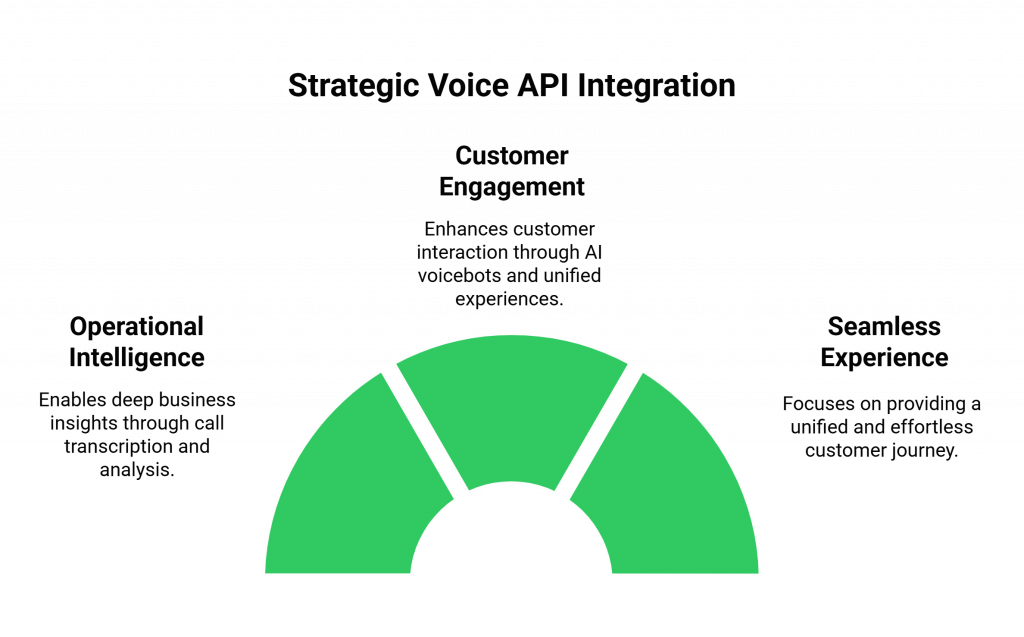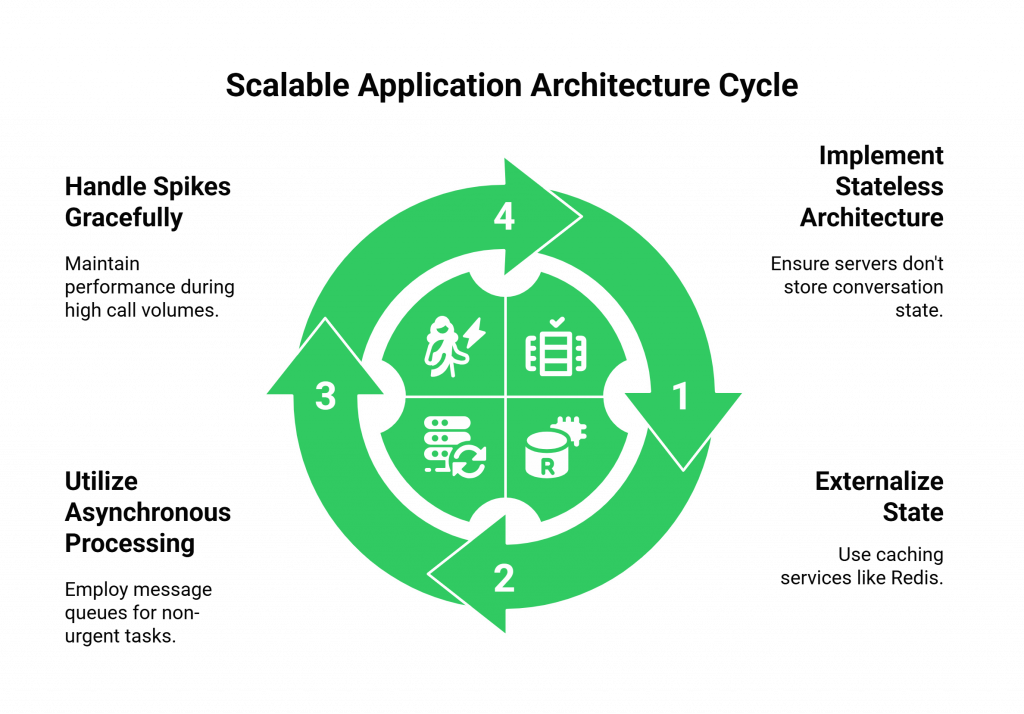For generations, the business phone system was a closed box, a utility that worked, but one you could not innovate on. Today, that box has been blown wide open. Voice is no longer just a utility; it’s a programmable asset, a piece of digital clay that can be molded into intelligent automated agents, powerful analytics tools, and seamless customer experiences. The tool that makes this all possible is the modern voice API for developers.
But for an enterprise, integrating this new power is a high-stakes endeavor. A poorly architected voice API integration can lead to a cascade of problems: glaring security holes, frustrating customer experiences, and a system that collapses under the pressure of real-world traffic. A successful integration, on the other hand, can become a massive competitive advantage.
This guide is for the architects, the engineers, and the technical leaders. We will move beyond the basics and provide a clear, actionable set of best practices for building a secure, scalable, and resilient enterprise-grade voice solution that will stand the test of time.
Table of contents
- Why is a Voice API Integration a Strategic Imperative for Enterprises?
- What Are the Foundational Best Practices for Any Voice API Integration?
- How Should You Architect Your Application for Enterprise-Level Scale?
- What Makes FreJun AI the Best Voice API for Business Communications?
- Conclusion
- Frequently Asked Questions (FAQs)
Why is a Voice API Integration a Strategic Imperative for Enterprises?
For a modern enterprise, a voice API isn’t just another tool; it’s a strategic gateway to a new level of operational intelligence and customer engagement. It’s the essential bridge between your existing business logic and the world of conversational AI.

A well-executed voice API integration enables you to transcend the limitations of traditional telephony and unlock transformative capabilities. You can build an intelligent AI voicebot to automate routine support, transcribe and analyze every single call for deep business insights, and create a unified customer experience by connecting your voice channel directly to your CRM.
This focus on a seamless experience is what customers demand. A recent Salesforce report found that a remarkable 80% of customers say the experience a company provides is as important as its products and services.
What Are the Foundational Best Practices for Any Voice API Integration?
Before you write a single line of application code, you must establish a solid foundation. These are the non-negotiable architectural principles that ensure your voice solution is secure, reliable, and performant from day one.
How Do You Guarantee Security in Your Integration?
For an enterprise, security is not a feature; it’s the prerequisite. Your voice channel carries sensitive customer data, and it must be an impenetrable fortress.
- Secure Your Webhooks: Your application will receive real-time event notifications via webhooks. These endpoints must be secured. Always use HTTPS to encrypt the data in transit, and, most importantly, you must implement webhook signature validation to guarantee that every request is authentic and is coming from your trusted voice provider.
- Manage Your API Keys: Your API keys are the “keys to the kingdom.” They should be stored securely as secrets, never be hardcoded into your application, and be rotated regularly.
- Ensure End-to-End Encryption: The audio of the calls themselves must be encrypt. Insist on a provider that supports SRTP (Secure Real-time Transport Protocol) to protect the voice data as it travels over the network.
Also Read: Multimodal AI Agents 2025: Tools and Frameworks
How Do You Ensure Carrier-Grade Reliability?
Your phone system is a mission-critical utility. “Five nines” of uptime (99.999%) is the gold standard for a reason. The cost of downtime is catastrophic. A 2022 survey from the Information Technology Intelligence Consulting (ITIC) found that for 44% of large enterprises, a single hour of downtime costs over $1 million.
Your chosen voice API provider must have a globally distributed, redundant architecture that can automatically failover in the event of a data center outage.
How Do You Design for the Lowest Possible Latency?
In a voice conversation, every millisecond counts. To feel natural, the AI’s response must be nearly instant. This means you must design for low latency. This involves choosing a provider with a global network of Points of Presence (PoPs) and deploying your own application in a cloud region that is geographically close to both the voice provider’s PoP and the majority of your users.
How Should You Architect Your Application for Enterprise-Level Scale?
An application that works for a ten-call demo is fundamentally different from one that can handle ten thousand concurrent calls. Architecting for scale requires a specific set of design patterns.

Why Must You Embrace a Stateless Architecture?
This is the golden rule of scalable systems. Your backend application servers should not store any memory (or “state”) of an ongoing conversation. This allows you to run a fleet of identical, interchangeable servers behind a load balancer.
If one server gets busy or fails, the next request for that same call can be handle by any other available server without losing context. The conversational “state” should be externalize to a separate, highly scalable caching service like Redis.
How Can You Use Asynchronous Processing to Handle Spikes?
Not every task needs to happen in real-time. For non-urgent, post-call tasks, like generating a detailed summary, sending a follow-up email, or pushing analytics data to a warehouse, you should use a message queue (like RabbitMQ or AWS SQS).
This decouples your real-time conversational logic from your slower, backend processing. It makes your system far more resilient and allows it to gracefully handle sudden spikes in call volume without slowing down the live conversations.
Also Read: Best Local LLM Voice Assistants for Data Privacy
What Makes FreJun AI the Best Voice API for Business Communications?
Choosing your voice infrastructure is the most critical decision in your integration journey. While many providers offer a voice API, an infrastructure-first platform like FreJun AI is specifically engineered for the demands of a custom, enterprise-grade deployment.
Think of it this way: we build the global, carrier-grade highway. You get to design and run your own fleet of high-performance vehicles (your AI and your applications) on it. Our philosophy is simple: “We handle the complex voice infrastructure so you can focus on building your AI.”
- Model-Agnostic Freedom: We are not an all-in-one, closed ecosystem. We are a model-agnostic platform. This is a critical advantage for an enterprise. It means you are never locked into a single AI provider. You have the complete freedom to build a “best-of-breed” AI stack, using the most powerful and cost-effective models from Google, OpenAI, Anthropic, or any other provider. This makes your architecture future-proof.
- A True Developer-First Experience: We are obsessed with creating the best voice API for developers. Our API is clean, our documentation is meticulous, and our SDKs are designed to make the integration process as smooth as possible. We provide the robust tools, like reliable webhooks and real-time streaming, that are essential for building a sophisticated voice AI.
- An Unrelenting Focus on Performance: Our entire global network is engineered for ultra-low latency and high availability. We understand that for an enterprise, performance and reliability are non-negotiable.
Ready to build a truly custom voice AI on a rock-solid foundation? Sign up for FreJun AI developer platform.
Also Read: Voice-Based Bot Examples That Increase Conversions
Conclusion
A successful voice API integration is a powerful strategic asset for any modern enterprise. It’s the key that unlocks a new world of automation, business intelligence, and enhanced customer engagement. But this power comes with responsibility.
By following these best practices, prioritizing security, designing for reliability, and architecting for scale, you can build a voice solution that is not only innovative but also robust and resilient.
And by choosing the right foundational partner, you ensure that your integration is not just a project for today, but a strategic platform for the future.
Want to learn more about the infrastructure that powers the most advanced voice API integrations? Schedule a demo with FreJun AI today.
Also Read: Outbound Call Center Software: Essential Features, Benefits, and Top Providers
Frequently Asked Questions (FAQs)
Its main purpose is to provide a secure, reliable, and scalable bridge between an enterprise’s custom applications (like an AI voicebot or analytics engine) and the global public telephone network, abstracting away the underlying complexity of telephony.
The voice API is what your application uses to send commands to the voice platform (e.g., “make a call,” “play this audio”). A webhook is what the voice platform uses to send event notifications to your application (e.g., “a call is incoming,” “the call has ended”).
The most critical security measure is webhook signature validation. The voice platform signs every request with a secret key, and your application must verify this signature to ensure the request is authentic and not from a malicious actor.
It means the application servers that handle the real-time logic of the call do not store any conversational history. The “state” of each conversation is stored in a separate, external database or cache (like Redis), which allows any server to handle any request for any call at any time.
It’s important because the AI landscape is changing rapidly. A model-agnostic platform gives an enterprise the freedom to always use the best-performing or most cost-effective AI models on the market, preventing vendor lock-in and future-proofing their investment.
Synchronous processing happens in real-time during the live call (e.g., the STT-LLM-TTS loop). Asynchronous processing happens in the background, after the call has ended (e.g., generating a detailed summary). Using a message queue for asynchronous tasks is a key best practice for building resilient, scalable systems.
The best approach is a multi-region deployment. By running your application in multiple, geographically separate cloud data centers, and using a voice provider with a global network, you can ensure that your service remains online even if one entire region experiences an outage.
SRTP stands for Secure Real-time Transport Protocol. It’s the standard for providing encryption for the audio of a VoIP call, protecting the conversation from being intercepted as it travels over the internet.
The very first step is a thorough architectural design session. Before writing any code, map out your requirements for security, scale, and reliability, and choose your foundational voice infrastructure provider.
